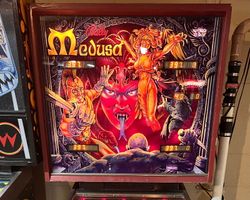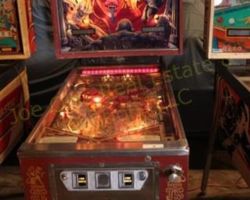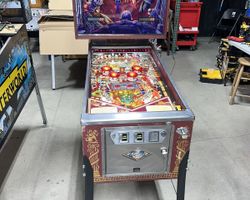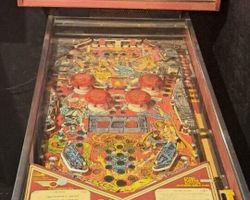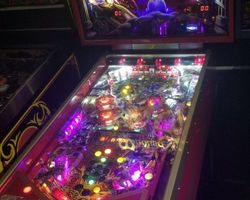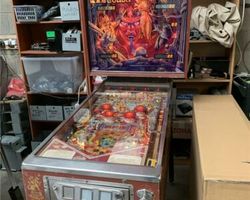Medusa

Average Prices: USD $300 to $2,000
Produced: September, 1981
Production Run: 3,250 units
Machine Type: Solid State Electronic
MPU: Bally MPU AS-2518-35
Players: 4
Design by: Wally Welch
Art by: Kevin OConnor, Kevin O'Connor
Bally Manufacturing Corporation released "Medusa" in September 1981, a solid-state electronic pinball machine that drew players into a world of Greek mythology and fantasy. Designed by Wally Welch with striking artwork by Kevin O'Connor and software by Rehman Merchant, Medusa became a notable release in Bally's production line during a period of intense innovation in pinball. Its production run of 3,250 units under model number 1245 positioned it as a collectible machine, especially given its unique features that set it apart from its contemporaries.
One interesting aspect of Medusa's development lies in its visual presentation. The game's backglass artwork, while captivating in its final form, underwent a revision. Artist Kevin O'Connor initially produced a more revealing depiction of Medusa, which he later modified at the request of Bally's marketing department. This minor alteration highlights the creative process and the considerations involved in presenting a pinball machine to a broader audience. Medusa also holds a distinct place in pinball history as the final machine to feature the "Zipper Flippers" mechanism, and it was the only solid-state game to ever incorporate them, marking the end of an era for this specific playfield interaction. Furthermore, it shared another rare feature with only one other Bally machine from the same year, "Fireball II": a player-controlled rubbered post between the flippers, known as the "Shield of the Gods." Bally’s slogan for the game, "Bally MEDUSA… A Legend of Features," hinted at the distinctive elements players would encounter.
Signature Features and Design
"Medusa" stands out through its unique mechanical and artistic integrations, all contributing to a cohesive mythological theme. The most talked-about elements are undoubtedly the "Zipper Flippers." Located in the upper playfield, these two flippers can physically close the gap between them, preventing the ball from draining directly down the center. This timed locking mechanism, activated upon achieving specific game goals, transforms the upper playfield, offering a momentary reprieve or a new strategic window for shots. It’s a compelling physical feature that genuinely alters the flow of gameplay.
Complementing this is the "Shield of the Gods," a player-controlled rubbered post situated between the main lower flippers. Players can activate this post with a button press, causing it to spring up and potentially deflect a rapidly draining ball back into play. This feature injects a layer of active defense into the game, rewarding quick reflexes and strategic timing with a satisfying save. Both the Zipper Flippers and the Shield of the Gods provide tangible mechanical interactions that go beyond standard flipper and bumper action, enhancing the game's tactile appeal.
Kevin O'Connor's artwork for Medusa is a major draw, universally recognized for its striking beauty and thematic consistency. The Greek mythology theme is rendered with vibrant colors, particularly shades of red, across the cabinet, backglass, and playfield. The Medusa character herself is central, surrounded by mythical creatures and architectural elements that transport players to an ancient world. The visual aesthetic is further amplified by the machine’s lighting. Red translucent flippers illuminate from underneath, casting a distinctive glow, while a row of red lights along the top of the playfield dynamically indicates bonus progression. Digital displays integrated into the playfield provide essential game information, blending functionality with the overall visual design. The custom speech, delivered with a synthesized, somewhat spooky male voice, contributes to the game's atmosphere, even if some players later expressed a preference for a female voice to better align with the theme.
Playfield and Mechanics
The "Medusa" playfield is characterized by a unique layout that encourages strategic play and mastery of its distinct features. It offers a "dual playfield" sensation, largely due to the prominence of the upper playfield area and its distinct objectives. The overall layout is symmetrical and challenging, designed to keep players engaged with a variety of shots.
At the lower half, four flippers—two standard at the bottom and the two "Zipper Flippers" in the upper-mid playfield—provide primary ball control. Surrounding these are four pop bumpers, two slingshots, and seven star rollovers that contribute to score accumulation and bonus activation. The centerpiece of target-based scoring involves eleven drop targets: a formidable 7-bank and a smaller 4-bank. Hitting these targets not only advances game objectives but also opens up pathways or lights features. Additionally, six standup targets and four rollunders offer further scoring opportunities. A single kick-out hole adds an element of surprise, returning the ball to the playfield after specific conditions are met.
The playfield art is detailed and immersive, complementing the mythological theme with intricate designs and vivid imagery that guide the player's eye towards key shots. The lighting scheme is integral to the game’s aesthetic and gameplay; the illuminated flippers and dynamic light show along the top of the playfield provide visual feedback and contribute to the atmosphere. The design philosophy behind Medusa's layout appears to prioritize precision and the strategic use of its unique mechanics. The wide outlanes, often guarded by mini-posts, demand accurate shots and flipper control, reinforcing the game's challenging nature. The playfield's complexity, while visually rich, can initially appear dark to new players, but for enthusiasts, it unveils layers of strategic depth.
Gameplay Dynamics
"Medusa" offers a challenging and deep gameplay experience that rewards precise shot-making and strategic thinking. The core progression revolves around advancing bonus multipliers and conquering various objectives on the playfield. The drop targets, especially the imposing 7-bank, are central to this progression, often revealing pathways or lighting features necessary for higher scoring. The game also incorporates a unique skill shot, requiring a precisely timed manual plunge with optimal velocity to hit specific rollover switches, which can prove rewarding when executed successfully.
The "Zipper Flippers" are not just a visual novelty but a core gameplay mechanic. When activated, the flippers in the upper playfield close, creating a temporary barrier that prevents ball drains and often enables specific shots into a concentrated area for bonus accumulation or objective completion. The "Shield of the Gods" adds another layer of player interaction, allowing for reactive saves during intense moments, though its timing must be impeccable to be effective.
Gameplay often focuses heavily on the upper playfield, where the Zipper Flippers and a cluster of targets demand attention. Successfully navigating this area, completing drop target banks, and activating bonuses are key to high scores. The game’s rules, while complex, encourage players to explore different shot combinations and react to the ever-changing playfield state. The synthesized male voice and distinct vintage Bally sounds punctuate gameplay, signaling successful shots and mode activations. While the absence of multiball is a frequent observation among players, the intricate single-ball play, the constant challenge, and the unique features contribute to a compelling and often demanding pinball session.
Reception and Legacy
"Medusa" generally garners a positive reception within the pinball community, often described as a challenging and highly enjoyable game from Bally's early 1980s era. Its artwork is almost universally praised as stunning and captivating, with many highlighting Kevin O'Connor's vibrant use of color and the immersive Greek mythology theme. This visual appeal is a significant factor in its enduring popularity.
The machine's unique features receive considerable acclaim. The "Zipper Flippers" are frequently cited as a standout innovation, adding strategic depth and excitement to the upper playfield. The "Shield of the Gods" center post kickback is also highly regarded for providing satisfying, clutch saves and enhancing player interaction. The timed plunge skill shot and the effective lighting, particularly the illuminated flippers and rear lightbar, further contribute to its strengths. Players often describe the game as fast-paced, challenging, and addictive, fostering a strong "play it again" desire despite its difficulty. Its distinctiveness and relative rarity have also made it a collectible and desirable machine over time.
However, "Medusa" is not without its critiques. It is often labeled a "drain monster" due to its unforgiving outlanes and a steep learning curve, leading some players to find it brutally difficult. Some feedback suggests the gameplay can become repetitive, with a heavy emphasis on repeatedly targeting the upper playfield, potentially underutilizing the lower playfield in the process. The ruleset, while deep, can be challenging for new players to grasp without significant time and effort. Minor technical points, such as the skill shot's reliance on rollover switches that can fail with a fast-moving ball, have also been noted. The lack of a multiball mode, common in many later machines, is another frequent point of discussion among enthusiasts, with some feeling it would have enhanced the game’s excitement. Despite these points, "Medusa" maintains a strong reputation as a classic and a test of skill. Its unique features and the distinct atmosphere it creates solidify its place in pinball history, particularly as the final solid-state machine to employ Zipper Flippers, marking its singular influence on design and innovation within the industry.
Sponsored Links
 Ebay Listings
Ebay Listings
 Auction Results
Auction Results
| Cost | Location | Date |
|---|---|---|
| USD $3,300 |  Ohio, United States Ohio, United States |
12 September, 2024 |
| USD $4,499 |  California, United States California, United States |
01 April, 2024 |
| USD $1,410 |  Illinois, United States Illinois, United States |
13 April, 2023 |
| USD $6,495 |  Canada Canada |
10 January, 2023 |
| USD $3,400 |  Michigan, United States Michigan, United States |
13 November, 2022 |
| USD $3,250 |  California, United States California, United States |
12 September, 2022 |
| USD $5,150 |  New Jersey, United States New Jersey, United States |
17 February, 2022 |
| USD $10,999 |  Florida, United States Florida, United States |
03 February, 2022 |
| GBP £2,126 |  United Kingdom United Kingdom |
29 August, 2021 |
| GBP £1,021 |  Leicester, United Kingdom Leicester, United Kingdom |
25 July, 2021 |


Private Policy · Search Website · Contact Us
As an eBay Partner, we may earn a commission from qualifying purchases made through links on this site, at no additional cost to you.
All trademarks and copyrighted materials remain property of their respective owners. All other content copyright 2007 - 2025 Pinpedia.

